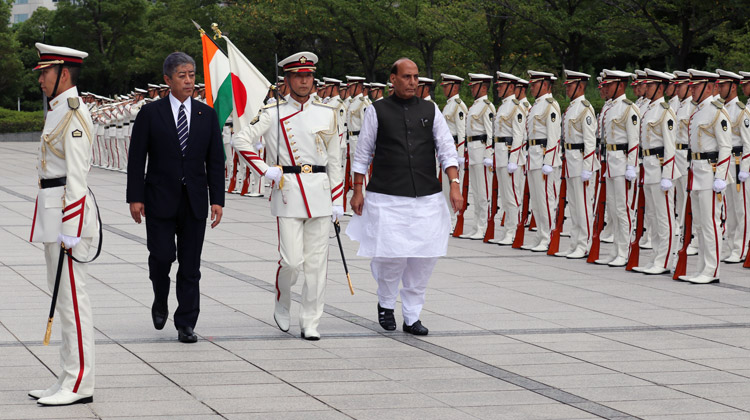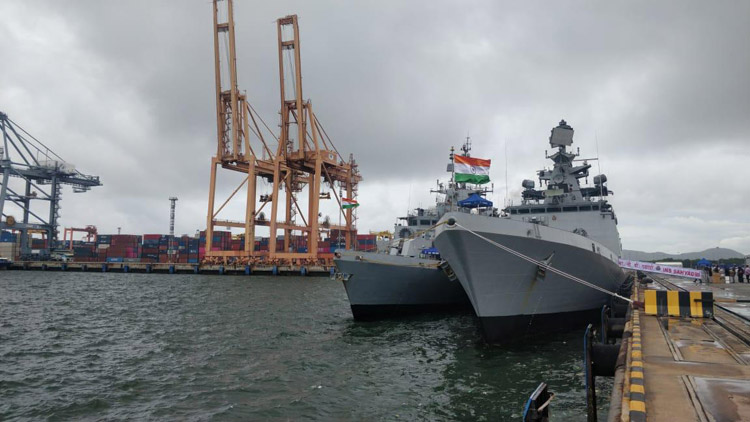- Prime Minister Narendra Modi inaugurates Aero India 2023 in Bengaluru; Releases Commemorative Stamp
- Defence Secretary meets delegations from Saudi Arabia, USA and Oman on the sidelines of Aero India 2023
- Foreign Ministers of 32 countries to attend Aero India 2023
- Embraer showcases the C-390 Millennium at Aero India 2023
Looking East, India steps up military diplomacy in the Indo-Pacific with high profile visits
Defence Minister in Japan, Navy Chief in Australia and warships in Thailand.

India stepped up military diplomacy in the Indo-Pacific as part of its Look East priority, with the presence of Defence Minister Rajnath Singh in Japan, Navy Chief Admiral Karambir Singh in Australia and two Eastern Fleet warships in Thailand at the same time.
Defence Minister Rajnath Singh lobbied Japanese Prime Minister Shinzo Abe on Kashmir, and made common cause on regional security while co-chairing the Japan-India Defence Ministerial Meeting with his counterpart Takeshi Iwaha in Tokyo on September 2. Both sides have common concerns over an assertive China.
"There was a general understanding that more cooperation should be realised in Defence Equipment and Technology Cooperation (with Japan)," according to a statement released by India's Ministry of Defence
"There was a general understanding that more cooperation should be realised in Defence Equipment and Technology Cooperation (with Japan)," according to a statement released by India's Ministry of Defence.
The Defence Minister donned his quasi diplomatic hat in stressing to the Japanese premier that the abrogation of Article 370 benefits the people of Jammu and Kashmir and Ladakh and is an internal matter of India in which Pakistan has no locus standi, and that talks and terror can't go together.

Navy Chief Admiral Karambir Singh is on a tour of Australia and New Zealand from September 2 to 6. The visit would consolidate existing maritime cooperation initiatives as well as explore new avenues with Australia and New Zealand, a Naval press release stated. Admiral Singh will hold meetings with the military top brass of the two countries.
Admiral Karambir Singh's visit explores stepping up the military dimension of deepening ties with Australia, particularly in the context of recent momentum to the 'Quad' security construct involving the US, India, Japan and Australia, which too is bound together because of uncertainties created by the rise of an aggressive China.
Admiral Karambir Singh's visit explores stepping up the military dimension of deepening ties with Australia, particularly in the context of recent momentum to the 'Quad' security construct involving the US, India, Japan and Australia, which too is bound together because of uncertainties created by the rise of an aggressive China
The defence relationship with Australia is enabled by the 2006 Memorandum of Defence Cooperation, the 2009 Joint Declaration on Security Cooperation and the 2014 Agreement on a Bilateral Framework for Security Cooperation.
The third edition of the bilateral naval exercise AUSINXDEX in April 2019 saw the largest participation from both sides, which are also partners in the Indian Ocean Naval Symposium, which is India's maritime cooperation construct.
Naval ties with New Zealand go back to World War I, and the two sides are looking for ways to expand military cooperation.
In another prominent East Asian capital, Eastern fleet warships INS Sahyadri and Kiltan are flying the Indian flag during a port call at Laem Chabang, Bangkok, from August 31 to September 3. The two warships are also meant to demonstrate the coming of age of India's warship building capabilities. Sahyadri is an indigenously designed and built guided missile stealth frigate while Kiltan is an anti-submarine warfare corvette.
This port call is also an opportunity to interact with the Thai Navy brass. On completion of the visit, the Indian and Thai Navies will take part in a passage exercise at sea to further build on the levels of interoperability in the very busy shipping lanes around the two countries in which China is showing increasing military presence.





